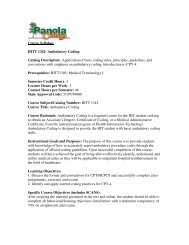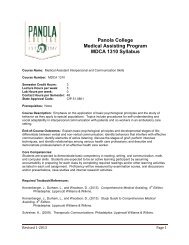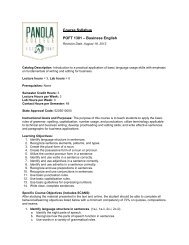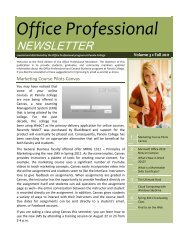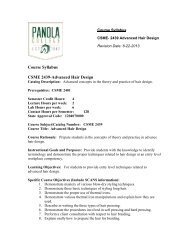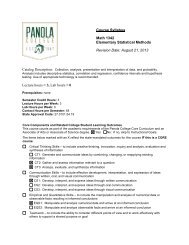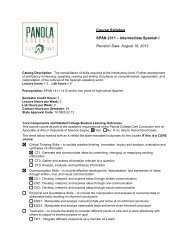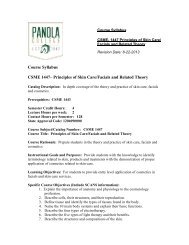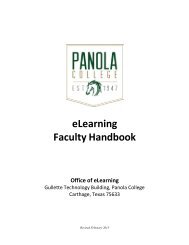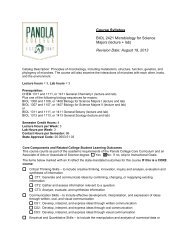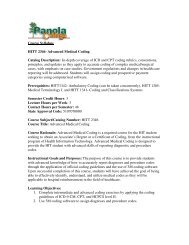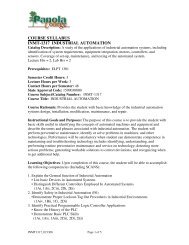Course Syllabus ITSC 1325 â Personal Computer ... - Panola College
Course Syllabus ITSC 1325 â Personal Computer ... - Panola College
Course Syllabus ITSC 1325 â Personal Computer ... - Panola College
Create successful ePaper yourself
Turn your PDF publications into a flip-book with our unique Google optimized e-Paper software.
<strong>Course</strong> <strong>Syllabus</strong><br />
<strong>ITSC</strong> <strong>1325</strong> – <strong>Personal</strong> <strong>Computer</strong> Hardware<br />
<strong>Course</strong> Description: This course is a study of current personal computer hardware including personal<br />
computer assembly and upgrading, setup and configuration, and troubleshooting. Lecture hours = 3, Lab<br />
hours = 1<br />
Prerequisites: COSC 1301<br />
Semester Credit Hours: 3<br />
Contact Hours per Semester: 64<br />
State Approval Code: 47.0104<br />
<strong>Course</strong> Subject/Catalog Number: <strong>ITSC</strong> <strong>1325</strong><br />
<strong>Course</strong> Title: <strong>Personal</strong> <strong>Computer</strong> Hardware<br />
<strong>Course</strong> Rationale: This course develops student’s technology skills required for troubleshooting<br />
computer software and hardware problems. Students will learn software and hardware troubleshooting<br />
techniques used to identify and correct computer problems.<br />
Instructional Goals and Purposes: The purpose of this course is teach students to assemble/setup and<br />
upgrade personal computer systems; diagnose and isolate faulty components; optimize system<br />
performance; and install/connect peripherals.<br />
Learning Objectives:<br />
1. Assemble/setup and upgrade personal computer systems<br />
2. Perform installation, configuration, and upgrading of microcomputer hardware and software.<br />
3. Install/connect associated peripherals.<br />
4. Diagnose and troubleshoot microcomputer systems hardware and software, and other peripheral<br />
equipment.<br />
Specific <strong>Course</strong> Objectives (includes SCANS):<br />
After studying the material presented in the text and online, the student should be able to complete all<br />
behavioral/learning objectives listed below with a minimum competency of 70% on assignments and<br />
exams.<br />
1. Assemble/setup and upgrade personal computer systems. (1a-i, 1a-ii, 1a-iv, 1b-iv, 1b-v, 2c-i,<br />
2c-ii, 2c-iii, 2c-iv)<br />
a. Identify modules that make up a computer system and its operation<br />
b. Understand that a computer requires both hardware and software to work.<br />
c. Describe the different hardware components inside of and connected to a computer.<br />
d. Identify each type of computer bus structure<br />
e. Learn about the many different processors used for personal computers and notebook<br />
computers<br />
2. Perform installation, configuration, and upgrading of microcomputer hardware and<br />
software. (1a-i, 1a-iv, 1b-iv, 1b-vi, 1c-iv, 2c-i, 2c-ii, 2c-iii, 2c-iv)<br />
a. Assemble/setup microcomputer systems, accessory boards<br />
b. Learn about the different types of motherboards and how to select one<br />
<strong>ITSC</strong> <strong>1325</strong> _ 030608 1 of 5
c. Install or replace a motherboard<br />
d. Troubleshoot problems with memory<br />
3. Install/connect associated peripherals. (1a-i, 1a-iv, 1b-i, 1b-iii, 1b-iv, 1b-vi, 2c-i, 2c-ii, 2c-iii, 2civ,<br />
2d-iii)<br />
a. Learn how printers and scanners work<br />
b. Install printers and scanners and how to share a printer over a local area network.<br />
c. Troubleshoot printer and scanner problems.<br />
d. Solve hard drive problems<br />
4. Diagnose and troubleshoot microcomputer systems hardware and software, and other<br />
peripheral equipment. (1a-i, 1a-iv, 1b-iv, 2c-ii, 2c-iv)<br />
a. Understand how to approach and solve a PC problem.<br />
b. Troubleshoot a failed boot before the OS is loaded.<br />
c. Describe the general approaches you need to take when installing and supporting I/O<br />
devices<br />
d. diagnose and isolate faulty components<br />
<strong>Course</strong> Content:<br />
Students in all sections of <strong>Personal</strong> <strong>Computer</strong> Hardware will be required to do the following:<br />
1. Students will submit computer programs for each learning module of the course. Each program<br />
must demonstrate comprehensive knowledge of the learning module represented.<br />
2. Students will assemble a portfolio of lab/labsim projects to be submitted at the end of the<br />
semester.<br />
3. Students will conduct an interactive presentation of a comprehensive hardware trouble-shooting<br />
project subject to peer and instructor evaluation.<br />
Methods of Instruction/<strong>Course</strong> Format/Delivery:<br />
Students in both the traditional class and in the Internet class will have access to this course via WebCT.<br />
Students in the traditional class will meet regularly for lecture over the material. Students in the Internet<br />
class will only be required to meet with the instructor for testing; however, Internet students are always<br />
welcome to attend the traditional class (especially for exam reviews). Resources provided through<br />
WebCT include<br />
• A calendar displaying assignments each week (please check often)<br />
• Online assignments<br />
• Chapter notes<br />
• Email (totally contained within WebCT)<br />
All assignments will be submitted through WebCT. After the assignment has been graded, the<br />
student will be able to view his or her grade by returning to the assignment and clicking the View<br />
Scores button or by clicking the My Grades link in the left banner. All exams will be hands-on<br />
application tests and students will not be able to view the answers to the exams online; however,<br />
they will be able to see their grade in My Grades and drop by the office to review their exams. I<br />
generally will have your work graded and posted within two days following the deadline.<br />
Students in both the traditional and Internet classes should use the Email within WebCT to communicate<br />
with the instructor. Using WebCT email gives you access to the instructor and other classmates without<br />
having to remember or type email addresses—you just select a name from the list. If you are not able to<br />
contact me using email in WebCT, you may use my <strong>Panola</strong> <strong>College</strong> email address. I attempt to respond<br />
to all email within 24 hours. If you make an appointment with me through email to take an exam, for<br />
example, I will reply to your email—if I do not reply, you should send your email to me again or call me.<br />
Please always include a subject line and your name in your email.<br />
Assessment:<br />
The following items will be assigned during the semester and used to calculate the student’s final grade:<br />
• ASSIGNMENTS<br />
We will work through each of the learning modules which correspond to the chapters in your<br />
textbook. At the end of each learning module, you will complete a Labsim project demonstrating<br />
<strong>ITSC</strong> <strong>1325</strong> _ 030608 2 of 5
your knowledge of the programming concepts presented in the learning module. Projects will be<br />
submitted to me according to the schedule provided using the online drop box in the Assignments<br />
link of WebCT.<br />
• PORTFOLIO<br />
The portfolio will be a collection of all Labsim work completed during the semester including a<br />
comprehensive presentation project to be completed in the final weeks of the semester.<br />
Portfolios are due by the scheduled deadline.<br />
• EXAMS<br />
There will be one assessment to verify that you have the comprehensive knowledge required to<br />
produce your portfolio. You will demonstrate this knowledge by conducting an interactive<br />
presentation of a comprehensive project subject to peer and instructor evaluation.<br />
<strong>Course</strong> Grade:<br />
The grading scale for this course is as follows:<br />
• Assignments – 20%<br />
• Portfolio – 50%<br />
• Exams – 30%<br />
All of your grades including a mid-semester and final grade will be posted to My Grades in WebCT.<br />
Texts, Materials, and Supplies: A+ Guide to Hardware: Managing, Maintaining, and Troubleshooting,<br />
Fourth Edition, Jean Andrews bundled with LabSim for A+ Essentials, <strong>Course</strong> Technology ISBN 0-619-<br />
21762-6; ISBN-13: 978-0-619-21762-4<br />
Other:<br />
• For current texts and materials, use the following link to access bookstore listings:<br />
http://www.panola.edu/collegestore.htm<br />
• For testing services, use the following link: http://www.panola.edu/instruction/dl/testing.htm<br />
<strong>ITSC</strong> <strong>1325</strong> _ 030608 3 of 5
SCANS CRITERIA<br />
1) Foundation skills are defined in three areas: basic skills, thinking skills, and personal<br />
qualities.<br />
a) Basic Skills: A worker must read, write, perform arithmetic and mathematical operations, listen,<br />
and speak effectively. These skills include:<br />
i) Reading: locate, understand, and interpret written information in prose and in documents<br />
such as manuals, graphs, and schedules.<br />
ii) Writing: communicate thoughts, ideas, information, and messages in writing, and create<br />
documents such as letters, directions, manuals, reports, graphs, and flow charts.<br />
iii) Arithmetic and Mathematical Operations: perform basic computations and approach practical<br />
problems by choosing appropriately from a variety of mathematical techniques.<br />
iv) Listening: receive, attend to, interpret, and respond to verbal messages and other cues.<br />
v) Speaking: Organize ideas and communicate orally.<br />
b) Thinking Skills: A worker must think creatively, make decisions, solve problems, visualize, know<br />
how to learn, and reason effectively. These skills include:<br />
i) Creative Thinking: generate new ideas.<br />
ii) Decision Making: specify goals and constraints, generate alternatives, consider risks, and<br />
evaluate and choose the best alternative.<br />
iii) Problem Solving: recognize problems and devise and implement plan of action.<br />
iv) Visualize ("Seeing Things in the Mind's Eye"): organize and process symbols, pictures,<br />
graphs, objects, and other information.<br />
v) Knowing How to Learn: use efficient learning techniques to acquire and apply new knowledge<br />
and skills.<br />
vi) Reasoning: discover a rule or principle underlying the relationship between two or more<br />
objects and apply it when solving a problem.<br />
c) <strong>Personal</strong> Qualities: A worker must display responsibility, self-esteem, sociability, selfmanagement,<br />
integrity, and honesty.<br />
i) Responsibility: exert a high level of effort and persevere toward goal attainment.<br />
ii) Self-Esteem: believe in one's own self-worth and maintain a positive view of oneself.<br />
iii) Sociability: demonstrate understanding, friendliness, adaptability, empathy, and politeness in<br />
group settings.<br />
iv) Self-Management: assess oneself accurately, set personal goals, monitor progress, and<br />
exhibit self-control.<br />
v) Integrity and Honesty: choose ethical courses of action.<br />
2) Workplace competencies are defined in five areas: resources, interpersonal skills,<br />
information, systems, and technology.<br />
a) Resources: A worker must identify, organize, plan, and allocate resources effectively.<br />
i) Time: select goal-relevant activities, rank them, allocate time, and prepare and follow<br />
schedules.<br />
ii) Money: Use or prepare budgets, make forecasts, keep records, and make adjustments to<br />
meet objectives.<br />
iii) Material and Facilities: Acquire, store, allocate, and use materials or space efficiently.<br />
Examples: construct a decision time line chart; use computer software to plan a project; prepare a<br />
budget; conduct a cost/benefits analysis; design an RFP process; write a job description; develop<br />
a staffing plan.<br />
b) Interpersonal Skills: A worker must work with others effectively.<br />
i) Participate as a Member of a Team: contribute to group effort.<br />
ii) Teach Others New Skills.<br />
iii) Serve Clients/Customers: work to satisfy customer's expectations.<br />
<strong>ITSC</strong> <strong>1325</strong> _ 030608 4 of 5
iv) Exercise Leadership: communicate ideas to justify position, persuade and convince others,<br />
responsibly challenge existing procedures and policies.<br />
v) Negotiate: work toward agreements involving exchange of resources, resolve divergent<br />
interests.<br />
vi) Work with Diversity: work well with men and women from diverse backgrounds.<br />
Examples: collaborate with a group member to solve a problem; work through a group conflict<br />
situation, train a colleague; deal with a dissatisfied customer in person; select and use<br />
appropriate leadership styles; use effective delegation techniques; conduct an individual or team<br />
negotiation; demonstrate an understanding of how people from different cultural backgrounds<br />
might behave in various situations.<br />
c) Information: A worker must be able to acquire and use information.<br />
i) Acquire and Evaluate Information.<br />
ii) Organize and Maintain Information.<br />
iii) Interpret and Communicate Information.<br />
iv) Use <strong>Computer</strong>s to Process Information.<br />
Examples: research and collect data from various sources; develop a form to collect data;<br />
develop an inventory record-keeping system; produce a report using graphics; make an oral<br />
presentation using various media; use on-line computer data bases to research a report; use a<br />
computer spreadsheet to develop a budget.<br />
d) Systems: A worker must understand complex interrelationships.<br />
i) Understand Systems: know how social, organizational, and technological systems work and<br />
operate effectively with them.<br />
ii) Monitor and Correct Performance: distinguish trends, predict impacts on system operations,<br />
diagnose deviations in systems' performance and correct malfunctions.<br />
iii) Improve or Design Systems: suggest modifications to existing systems and develop new or<br />
alternative systems to improve performance.<br />
Examples: draw and interpret an organizational chart; develop a monitoring process; choose a<br />
situation needing improvement, break it down, examine it, propose an improvement, and<br />
implement it.<br />
e) Technology: A worker must be able to work with a variety of technologies.<br />
i) Select Technology: choose procedures, tools or equipment including computers and related<br />
technologies.<br />
ii) Apply Technologies to Task: understand overall intent and proper procedures for setup and<br />
operation of equipment.<br />
iii) Maintain and Troubleshoot Equipment: Prevent, identify, or solve problems with equipment,<br />
including computers and other technologies.<br />
Examples: read equipment descriptions and technical specifications to select equipment to meet<br />
needs; set up and assemble appropriate equipment from instructions; read and follow directions<br />
for troubleshooting and repairing equipment.<br />
<strong>ITSC</strong> <strong>1325</strong> _ 030608 5 of 5



